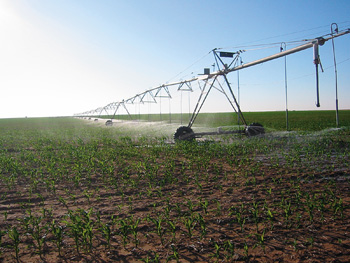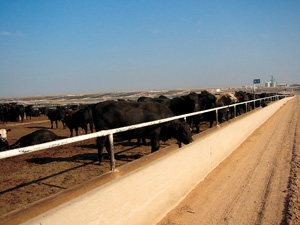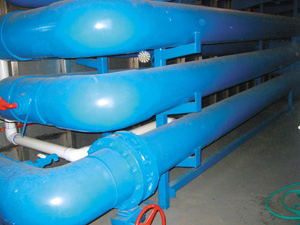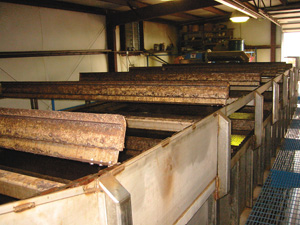
XIT Feeders of Texas has found the
Dissolved Air Floatation (DAF) wastewater treatment system has proven
itself—both in terms of effectiveness and ease of operation—on its
cattle operation.
XIT Feeders of Texas has found the Dissolved Air Floatation (DAF) wastewater treatment system has proven itself—both in terms of effectiveness and ease of operation—on its
cattle operation.
 Water from the process at XIT Feeders, much reduced of phosphorus content, is field applied using center pivot sprinklers. Water from the process at XIT Feeders, much reduced of phosphorus content, is field applied using center pivot sprinklers.
|
Tom McDonald’s description of the system in place at XIT Feeders would be music to the ears of livestock operators looking for simplicity in separating phosphorus from wastewater in their own manure management operations.
“What we are doing at XIT is actually very simple,” says McDonald, director of environmental planning and compliance for Five Rivers Ranch Cattle Feeding LLC, which owns and operates XIT Feeders of Dalhart, Texas. “There’s no rocket science to it; the system uses very established technology for wastewater.”
XIT Feeders has a Dissolved Air Floatation (DAF) wastewater treatment system in place which—over the past four years—has proven itself, both in terms of its effectiveness and ease of operation.
XIT is a 75,000-head cattle feedyard located in the northwest of the Texas panhandle. Initially set up as a 33,000-head facility in 1972, it has expanded over the years and, as a result, so has its output of wastewater and manure. The 75,000 cattle in the 540-acre operation at XIT generate one heck of a lot of wastewater: an average of 95 million gallons a year, all of which is handled by the DAF system.
 The 75,000 cattle at the XIT operation generate a lot of wastewater—an The 75,000 cattle at the XIT operation generate a lot of wastewater—an average of 95 million gallons a year, all of it handled by the DAF system. |
McDonald was involved in the choice of going for the DAF system. He explains that their options at the time were threefold: to go for additional application on other farms; acquire additional land for application; or opt for wastewater treatment. The wastewater route was the best way to go, they decided.
“We explored the options in wastewater treatment, and it seemed like the aluminum treatment DAF system made the most sense,” says McDonald. “Although XIT was the first DAF system of its kind in the feedyard business, it’s a proven technology in other industries. Virtually every processing plant or wastewater treatment plant has a DAF system.”
McDonald first became familiar with the system through one of ContiGroup’s poultry processing plants, which used a DAF system for taking fats and grease out of wastewater. “When that connection was made, we wondered why the same system couldn’t work at a cattle feedyard,” he explains.
Before going ahead with a full-fledged system, they carried out some basic bell jar tests, and then set up a small pilot plant. The pilot plant, set up on a flat bed, included a production DAF tank that had been used in a smaller application. “That proved to be very effective and we decided to go ahead from there,” relates McDonald.
The DAF system handling wastewater at XIT is both simple and low maintenance. The wastewater is pumped to the DAF plant from the feedyard retention pond using a 50-horsepower pump and an underground pipeline.
 Wastewater is pumped into a serpentine 12-inch PVC pipeline (below) where aluminum sulfate is injected. Once out of the pipeline, liquid is moved into the 40-foot-long stainless steel DAF tank where microbubbles of air are added. Wastewater is pumped into a serpentine 12-inch PVC pipeline (below) where aluminum sulfate is injected. Once out of the pipeline, liquid is moved into the 40-foot-long stainless steel DAF tank where microbubbles of air are added. |
Wastewater is pumped into a serpentine (running back and forth) 12-inch PVC pipeline, and aluminum sulfate is injected. There is two minutes of contact between the aluminum sulfate and the water, allowing for the reaction to occur. Anionic and cationic polymers are also added. That two minutes is about the time it takes for the water to go from the start of the serpentine pipe to the discharge end.
During that time, the phosphorus, being a solid and heavy, starts precipitating out of the water.
The polymers—a positively-charged polymer and negatively charged polymer—start binding the flocks of aluminum phosphate together, creating a bigger conglomerate of mass.
“Ordinarily, the phosphorus would settle to the bottom, but we don’t want that because the equipment we’re using to take it out scrapes the sludge off the top.”
Once out of the serpentine pipeline, the liquid is moved into a 10-foot tall by 10-foot wide by 40-foot long stainless steel tank. In the tank, micro bubbles of air are added, which attach to these conglomerates of aluminum phosphate and float them to the top. Paddles, which run the full width of the tank, then scrape the sludge to one end. The phosphorus-laden sludge then drops into a hopper, and is moved outside to a storage area.
The water from the process, now much reduced of phosphorus content, is moved directly into a piping system for field application.
The sludge goes to a dirt pad. The dirt pad works well because the sludge is very wet—made up of up to 98 percent water when it exits the tank. “There is a large amount of sludge that is initially generated,” says McDonald, “but it dewaters to very little material.
 Paddles, which run the full width of the DAF tank, scrape the sludge to one end. The phosphorus-laden sludge then drops into a hopper. Paddles, which run the full width of the DAF tank, scrape the sludge to one end. The phosphorus-laden sludge then drops into a hopper. |
“The biggest surprise we’ve had out of the whole project is the small amount of sludge that is generated. When you initially run the numbers of what is going through the system, it sounds like you are going to have mountains of sludge piled around. But when it dries down, it really is a small amount of material.”
The sludge material is then used in the cattle pens, to pack in holes. “I guess it could be used for a number of things, but it’s a very good material to pack up holes.” Because the phosphorus in the material, by its structure, is bound up very tightly, even if it ends up back in the retention pond, it is not easily broken down.
“The reason this is so good environmentally is there is concern about material getting into surface water and causing algae bloom. But the algae cannot break the aluminum phosphate bond, so even if the material went straight into a lake, it’s not going to be a problem.”
Due to that strong bond, the material is said to be stable from pH 2 to pH 9. Since it’s not easily broken down, however, it is also not useable as a crop fertilizer.
XIT Feeders had some assistance both in designing the system and its set-up. Stewart Water Solutions Ltd of Gainesville, Georgia, provided the DAF system. In addition to offering consulting services, Stewart Water Solutions also offers turnkey DAF and biological systems.
General Chemical Corporation, which continues to supply the feedyard with aluminum sulfate, assisted greatly, McDonald says. The company helped with both testing and analysis. “They sent a chemist out and set up a lab right there with the wastewater. We were able to get tests done right on site to get the right balance of chemicals.
“Between General Chemicals, Stewart Water Solutions and in-house expertise, we were able to come up with the system that has worked so well for the last four years, and continues to work well today,” he says.
The DAF system and its infrastructure was directly modeled after facilities in other industries. “The part that made us nervous was we were going to be the first ones to ever set it up at a feedyard. We knew it would work, but it had never been proven.” In that sense, XIT truly was a pioneer in setting up this technology in a livestock operation.
There were some very minor mechanical glitches with the system that were remedied quickly. They had to replace a gear box when the paddles in the tank were jamming up with the scraper chain. “Outside of doing that, I can’t think of anything else we’ve had to do to the equipment.”
The chemical process worked; they got the wastewater chemistry down to the most efficient point by reviewing the samples, and making any necessary adjustments. They have found that removing two-thirds of the phosphorus to be the most efficient approach. “So the water leaving the DAF has about one-third of the amount of phosphorus it had when it entered the system,” says McDonald. “You can get more than that—we have pulled upwards of 90 percent of the phosphorus out—but it is pretty uneconomical at that point.
“The really interesting thing—from a chemical standpoint—is that also happens to be the most efficient in terms of matching the water agronomically to the crop.” By reducing the phosphorus by two-thirds, the wastewater can be applied to crops based more on the nitrogen content. “We get a balanced fertilizer for the crops. It works out really well,” says McDonald.
The water is applied to mostly forage sorghum and wheat—and some corn—crops using a center pivot system.
|
XIT now part of Five Rivers Ranch Cattle Feeding
Previously part of the ContiGroup (formerly the Continental Grain Company), XIT Feeders is now part of Five Rivers Ranch Cattle Feeding. The ContiGroup, one of the largest agri-business companies in the world, and Smithfield Foods announced an agreement in May to set up a 50/50 joint venture between their respective cattle feeding businesses, ContiBeef LLC and MF Cattle Feeding Inc. The resulting combination will be the largest cattle feeding company in the United States.
Five Rivers, based in Boulder, Colorado, has a combined total of 10 feedyards in Texas, Colorado, Idaho, Kansas and Oklahoma, with a one-time total feeding capacity of 811,000 head. ContiBeef was already one of the largest cattle feeding operations in the world, marketing over one million head of cattle annually, most of that from six company-owned feedlots.
Tom McDonald, director of environmental planning and compliance for Five Rivers Ranch Cattle Feeding LLC, notes that ContiBeef has worked hard to be progressive on the environment front, and that is expected to continue with Five Rivers. “We’ve been very pro-active and worked very diligently to enhance our environmental systems. We’re doing our best to be good environmental stewards—that’s one of the things we’d like to be known for.”
|
From the signing of the contract with Stewart Water System to the start-up of the DAF system was about six months. McDonald notes there was a fair bit of infrastructure—from pump systems to pipelines—to install before the system could be started up.
There is very little in terms of ongoing maintenance for XIT’s DAF system “outside of greasing some bearings,” says McDonald. “The system has chemical and injection pumps, so you have to watch those and make sure your chemicals stay in line, but it does not take any specialized training. I don’t want to downplay things, but there hasn’t been anything in terms of routine maintenance that the feedyard maintenance department hasn’t been able to take care of.
“And the beautiful thing,” he adds, “is when you don’t need to be treating wastewater, you shut it off and go away. It’s not like a biological treatment system where you have to worry about keeping your bugs alive. It’s a physical/chemical system—you turn it on and it works, you shut it off and it waits for you.”
While the DAF system works for XIT Feeders and its situation, McDonald emphasizes that manure management solutions are site specific, and that livestock operations should review all options, and choose a system that best fits their operation. “If a facility does not have enough land to manage their nutrients, getting more land is not a feasible option or they don’t want to manage more ground, I think this is something they could look at. I think it also offers a good alternative in terms of the water that is produced, in that it is matched to the needs of most crops. That’s a real positive.”
The system could also be a very good fit if there are concerns about run-off from livestock operations. Because the resulting aluminum phosphate material is bound so tightly, it is essentially an environmentally benign material.
McDonald adds that while they have a tank with their DAF system, retention ponds or earthen containments could serve the same purpose. “I believe the set-up we have is the most efficient way to accomplish what we want to do, but a tank is not absolutely necessary.
“I have a lot of confidence in the system,” McDonald adds. “We have enough results pre-treatment and post-treatment to say that you can remove two thirds of the phosphorus from the wastewater effectively.”
The solids side of manure management at XIT Feeders is all handled by contractors. Manure is loaded from the pens on to spreader trucks and applied to farms in the area. “We’re fortunate in that we’re in one of those places where there is enough feedlot activity so there is a manure spreading industry of its own,” says McDonald.